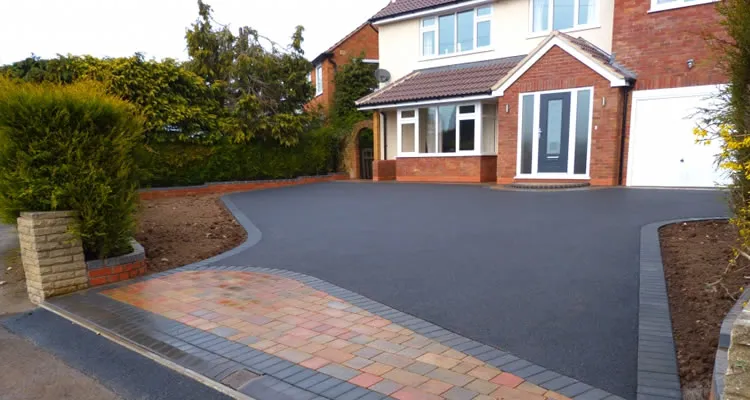Creating an eco-friendly driveway is a sustainable way to enhance your home’s curb appeal while minimizing environmental impact. If you want to make your tarmac coventry Beautiful we are here. This guide will walk you through the best materials, designs, and tips to create an environmentally conscious driveway.
1. Choose Eco-Friendly Materials
Selecting sustainable materials is the first step toward building an eco-friendly driveway. Here are some of the best options:
a) Permeable Pavers
- What They Are: Permeable pavers are designed to allow rainwater to seep through, reducing water runoff and helping with drainage.
- Materials: These pavers can be made from porous concrete, stone, or recycled materials like rubber and plastic.
- Eco-Benefits: They reduce the strain on local water systems by promoting natural water infiltration, helping to prevent flooding and erosion.
b) Recycled Asphalt (Reclaimed Asphalt Pavement)
- What It Is: Recycled asphalt is made from used asphalt that is reprocessed and reused for paving.
- Eco-Benefits: By reusing materials, you reduce the demand for new asphalt production, conserving energy and reducing greenhouse gas emissions.
c) Grass Pavers (Turf Pavers)
- What They Are: These pavers have open cells that allow grass to grow between them, offering both a solid surface for vehicles and a natural, green look.
- Eco-Benefits: They support the growth of vegetation, improve water absorption, and reduce heat buildup (urban heat island effect) compared to traditional hard surfaces.
d) Gravel
- What It Is: Gravel is a natural, loose aggregate material that allows rainwater to filter through.
- Eco-Benefits: It promotes natural drainage and can be sourced from local quarries, reducing transportation emissions.
2. Opt for Permeable Driveway Designs
Permeable driveways are designed to allow water to pass through, helping with drainage, preventing erosion, and replenishing groundwater supplies. Here are some design ideas:
a) Gravel with Pavers
- Combine gravel with permeable pavers to create a structured yet natural-looking surface. This design allows water to pass through while maintaining stability for cars.
b) Grass Driveway Strips
- Leave strips of grass between solid materials like concrete or pavers. This allows for natural water absorption while giving your driveway a green, eco-friendly appearance.
c) Reinforced Grass
- Use plastic grids or mesh systems that reinforce grass or turf, providing a strong base for vehicles while allowing grass to grow through.
3. Consider Sustainable Drainage Systems (SuDS)
Sustainable drainage systems (SuDS) help manage surface water runoff in an environmentally friendly way. Here are some SuDS techniques you can implement:
a) French Drains
- A French drain is a trench filled with gravel or rock that redirects water away from your driveway into a drainage area or underground pipe system.
- Eco-Benefits: Helps reduce flooding and erosion, while promoting water infiltration into the soil.
b) Swales
- Swales are shallow, vegetated channels that collect runoff and allow water to soak into the ground.
- Eco-Benefits: Reduces surface water runoff, prevents flooding, and recharges groundwater.
c) Rain Gardens
- Create a rain garden adjacent to your driveway. This is a planted area designed to absorb and filter rainwater runoff, promoting natural infiltration.
- Eco-Benefits: Encourages biodiversity, reduces pollution, and enhances water management.
4. Reduce Heat Island Effect
Traditional driveways made from asphalt or concrete can contribute to the urban heat island effect, where surfaces absorb and radiate heat, increasing local temperatures. To mitigate this, consider:
a) Light-Colored Materials
- Use light-colored materials like pale pavers, concrete, or gravel, which reflect more sunlight and absorb less heat.
- Eco-Benefits: Reduces the temperature around your home, decreasing the need for cooling systems and lowering energy consumption.
b) Green Driveways
- Incorporating vegetation, such as grass pavers or adjacent landscaping, can help cool the area around your driveway.
- Eco-Benefits: Natural surfaces lower local temperatures, improve air quality, and provide habitats for wildlife.
5. Use Recycled and Locally Sourced Materials
When building or renovating your driveway, consider using materials that are:
- Recycled: Such as reclaimed brick, concrete, or asphalt, which reduce waste and energy used in production.
- Locally Sourced: This reduces the carbon footprint from transportation and supports local industries.
6. Low Impact Maintenance
Maintaining an eco-friendly driveway also involves adopting low-impact practices:
- Use Natural De-icers: Instead of harmful salts or chemicals, use sand, gravel, or eco-friendly de-icers like calcium magnesium acetate to prevent ice buildup in winter.
- Minimize Water Use: Instead of power washing, use a broom to clean your driveway, and when water is necessary, opt for rainwater collected in barrels.
- Avoid Harsh Chemicals: Avoid using chemical cleaners or sealants, which can leach into the soil and harm the environment. Instead, opt for biodegradable and eco-friendly alternatives.
7. Install Solar-Powered Lighting
Solar-powered driveway lights are an energy-efficient way to illuminate your driveway at night:
- Eco-Benefits: Solar lights reduce electricity consumption, utilize renewable energy, and often come with motion sensors to minimize unnecessary light use.
8. Consider Electric Vehicle (EV) Charging Integration
If you have or plan to own an electric vehicle, consider installing an EV charging station as part of your driveway design. Choose solar-powered charging stations to further enhance your home’s sustainability.
9. Maximize Greenery Around the Driveway
Incorporating landscaping around your driveway not only enhances its beauty but also contributes to the environment:
- Plant Trees: Trees provide shade, reduce heat, and absorb CO2.
- Native Plants: Choose drought-tolerant or native plants around your driveway, which require less water and support local wildlife.
Conclusion
By choosing eco-friendly materials, designing for permeability, and adopting sustainable practices, you can create a driveway that not only looks great but also supports the environment. A sustainable driveway helps reduce water runoff, conserves natural resources, and lowers your home’s overall environmental impact—making it a win for both your property and the planet.
